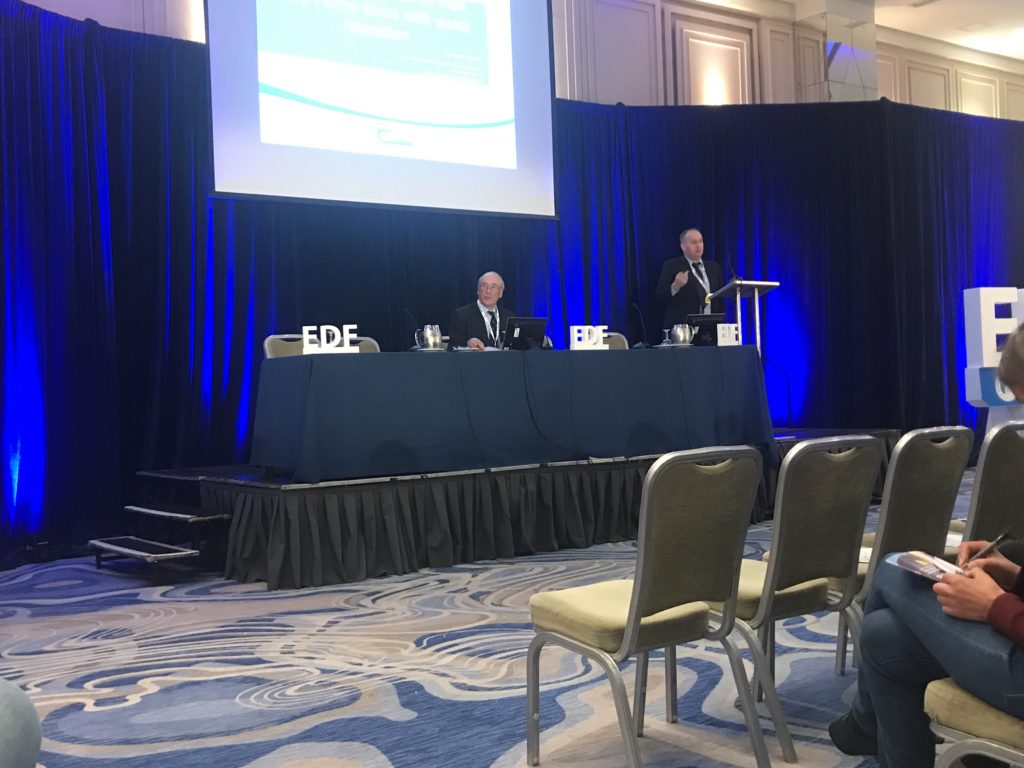The European Dairy Farmers (EDF) is holding its three-day congress in Co. Cork, with this being the EDF’s 30th congress.
The congress brings together more than 350 delegates from 28 countries including EDF members, leading industry figures, researchers and international speakers for a mixture of presentations, workshops and farm visits.
Originally scheduled for 2020, the conference was postponed due to the Covid-19 pandemic.

Irish dairy
Speaking at the EDF congress, Laurence Shalloo from Teagasc outlined the progression of the Irish dairy sector over the last ten years.
Shalloo outlined to the attendees at the event that Ireland now has the same number of cows as 1984 when milk quotas were introduced (1.5 million).
He explained that Irish dairy cow numbers decreased to around one million cows during quotas, but since 2015 have increased to 1.5 million.
In 1984, Ireland was producing 378,000kg of milk solids or 266kg of milk solids/cow. This figure is now just over 700,000kg of milk solids or 452kg of milk solids/cow.
Shalloo also explained that milk solids/cow in Ireland have increased by 12% since 2012, which is well ahead of other European countries.
He highlighted that since 2007, milk output from Ireland, in terms of solids, has increased by 93%.
This increased output is attributed to both increased cow numbers and increased output/cow.
Shalloo attributed the increase in dairy output from Ireland post-quotas to dairy being the most profitable sector in Irish agricultural sector, noting that Irish dairy farmers had a net margin of €97,000 in 2021.
He also noted that this is on the back of having the lowest milk price in Europe, and the lowest cost of production.

Seasonal milk production
Shalloo then looked at the seasonal dairy production system used in Ireland and noted that the processing capacity in Ireland is only used to 62% of its potential, while other countries in Europe uses their systems to 95% of their potential.
“That has a cost and that cost manifests itself in a lower milk,” he said.
“If we tried to flatten our curve, our competitiveness would be lost – we would be moving away from the grass model and losing our competitive advantage.”
Continuing, Shalloo said: “The driver of profitability is grass utilisation; as you increase grass utilisation you increase profitability.
“From an Irish context we’ve gone from 6.5t of grass utilised in 2008, up to 8.5t in 2021 – across the industry that increased utilisation is worth €350 million.”
Next decade
Shalloo then looked at the challanges and opportunities for the Irish dairy sector over the next 10 years.
The first point Shalloo focussed on was system creep, ensuring that Irish dairy farmers don’t move away from our grass-based system.
“It is really important when we look at our systems that we look at their impact on food security,” he said.
“When we look at total efficiency from a protein point of view, it’s not very useful because we can’t consume grass.
“But when we look at net efficiency, in terms of human eatable-in vs. human eatable-out, it is really an interesting point at how good our systems are.”
Continuing, Shalloo said: “When we compare a total mixed ration (TMR) vs. a grass-based system, we can see that TMR is roughly 1:1.
“You put in 1kg of human eatable, you get out 1kg of human eatable.
“Where in a grass-based system this is roughly 2.6:1, based on a French study published in 2018.
“We are currently looking at this and have found that it is roughly 4.2:1, so in Ireland for every 1kg of human eatable-in we get about 4.2kg of human eatable back.”
Shalloo added that on some of the most efficient Irish dairy farms this could be as high as 8:1.
The second challenge Shalloo highlighted was people, particularly attracting and keeping staff into the dairy sector.
He noted that this is potentially the biggest issue facing farmers in the next 10 years.
The next point he highlighted was green house gases (GHG); currently, the average national carbon footprint of an Irish dairy farm is 0.97kg CO2e/kg FPCM (kg of carbon dioxide equivalents/kg of fat and protein corrected milk).
The target for Irish dairy farms is 0.76kg CO2/KG FPCM, which has been already achieved on a number of farms.
Water quality was another area highlighted by Shalloo: “It is something that we need to put an effuses on to ensure that there is no deterioration in water quality as the sector expands.”
The final point highlighted by Shalloo was dairy and beef integration, which he noted as being an opportunity.

“At the moment, surplus calves from the dairy sector are going for export or into beef system here in Ireland,” he said.
“There is real opportunity to improve the quality of these calves, through better genetics and investment into profitable beef systems.
“Our strategy in terms of dairy and beef is that we look at it as a very strong opportunity for the dairy and beef industry to work together.”
